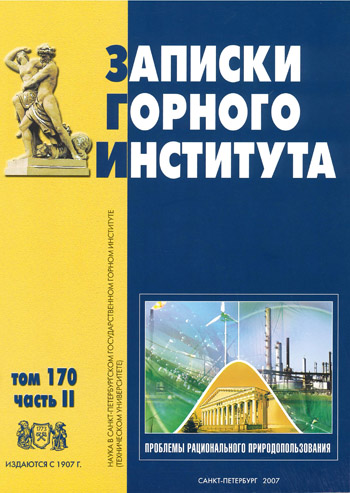Nitrification of high ammonia concentrations in membrane bioreactors - microbiological aspect
- 1 — Силезский технологический университет
- 2 — Силезский технологический университет
Аннотация
Очистка сточных вод при помощи активированного ила является одним из наиболееэффективных и распространенных методов очистки загрязненных вод. Активированный ил,являющийся смесью микроорганизмов, представляет собой великолепный материал как длямикробиологических, так и технологических исследований, ставящих целью нахождениеспособа эффективной утилизации различных химикатов. Данное исследование изучает вре-менные изменения в микробном сообществе на мембранах биореакторов очистных заводов,чьи сточные воды содержат большое количество аммиачного азота. Знание видового соста-ва и его изменчивости во времени в зависимости от факторов окружающей среды важно какс точки зрения экологии микроорганизмов, так и с технологической точки зрения. Задачейисследования являлось сравнение состава микробного сообщества активированного иладвух различных возрастов. Анализ проводился для оценки концентрации основных видовбактерий и структуры бактериального сообщества и сосредотачивался в основном на бакте-риях, окисляющих аммиак и нитриты. Основной задачей является ознакомление читателейс проблемой увеличивающейся нагрузки на окружающую среду со стороны азотсодержа-щих соединений в результате разнообразных видов человеческой деятельности. Очевидно,что охрана водных ресурсов является первостепенной задачей в мировом масштабе.
Литература
- Andreadakis, A.D.: Physical and chemical properties of activated sludge flocs. Wat. Res. 27(12), 1701-1714 (1993).
- Cicek N., Macomber J., Davel J., Suidan M. T., Audic J., Genestet P.: Effect of solids retention time on the performance and biological characteristics of a membrane bioreactor. Wat. Sci. and Tech. 43/11, 43–50 (2001).
- Choi, E., Eum, Y., Gil, K., Oa, S.: High strenght nitrogen removal from nightsoil and piggery wastes. Wat. Sci. Technol. 49/5-6, 97-104 (2004).
- Engelhardt N., Firk W., Warnken W.: Integration of membrane filtration into the activated sludge process in municipal wastewater treatment. Wat. Sci. and Tech. 38/4 – 5, 429 – 436 (1998).
- Fan X.J., Urbain V., Qian Y., Manem J.: Nitrification and mass balance with a membrane bioreactor for municipal wastewater treatment. Wat. Sci. and Tech. 34/1 – 2, 129 – 136 (1996).
- Fan X.J., Urbain V., Qian Y., Manem J., Ng W.J., Ong S.L.: Nitrification in a membrane bioreactor (MBR) for wastewater treatment. Wat. Sci. and Tech. 42/3 – 4, 289 – 295 (2000).
- Fux, C.: Biological nitrogen elimination of ammonium-rich sludge digester liquids. Doctoral Thesis, Swiss Federal Institute of Technology (2003).
- Gernaey, K., Verschuere, L., Luyten, L., Verstraete, W.: Fast and sensitive acute toxicity detection with as enrichment nitrifying culture. Wat. Res. 69 (6), 1163-1169 (1997).
- Ghyoot W., Vandaele S., Verstraete W. Nitrogen removal from sludge reject water with a membrane – assisted bioreactor. Wat. Res. 33/1, 23 – 32 (1999).
- Griffiths, B.S.: The effect of protozoa grazing on nitrification-implications from the application of organic wastes applied to siols. In: Hansen, A.A., Henriksen, K., editors. Nitrogen in Organic Wastes Applied to Soils. London: Academic Press, 37-46 (1989).
- Gűnder B, Krauth K. Replacement of secondary clarification by membrane separation – results with tubular, plate and hollow fibre modules. Wat. Sci. and Tech. 40/4 – 5, 311 – 320 (1999).
- Hao, X., Martinez, J.: Removing nitrate and ammonium from drainage water by simulation of natural biological processess. Wat. Res. 32/3, 936-943 (1998).
- Kishino H., Ishida H., Iwabu H., Nakano I.: Domestic wastewaters reuse using a submerged membrane bioreactor. Desalination 106, 115 – 119 (1996).
- Lee, N.M., Welander, T.: Influence of predators on nitrification in anaerobic biofilm process. Wat. Sci. Technol. 29/7, 335-63 (1994).
- Manoharan, R., Liptak, S., Parkinson, P., Mavinic, D.: Denitrification of a high ammonia leachate using an external carbon source. Environ. Tech. Letters 10, 701-716 (1989).
- Martinez, J.: A soil treatment process of pig slurry with subsequent denitrification of drainage water. J. Agric. Engng. Res. 66/1, 51-62 (1997).
- Morgan, J.W., Forster, C.F., Evison, L.: A comparative study of the nature of biopolymers extracted from anaerobic and activated sludges. Wat. Res. 24(6), 743-750 (1990).
- Resink, J. H., Rulkens, W. H.: Using metazoan to reduce sludge production. Wat. Sci. Technol. 36/11, 171-179 (1997).
- Rosenberger, S., Kraume, M.: Filterability of activated sludge in membrane bioreactors Desalination 146, 373-379 (2002).
- Schmidt, I., Sliekers, O., Schmid, M. Bock, E., Fuerst, J., Gijs Kuenen, J., .Jetten, M., Strous, M.: New concepts of microbial treatment processes for the nitrogen removal in wastewater. Microbiology Reviews 27, 481-492 (2003).
- Sundermeyer, H., Bock, E.: Energy metabolism of autotrophically and heterotrophically grown cells of Nitrobacter winogradskyi. Arch.Microbiol. 130, 250-254 (1981).
